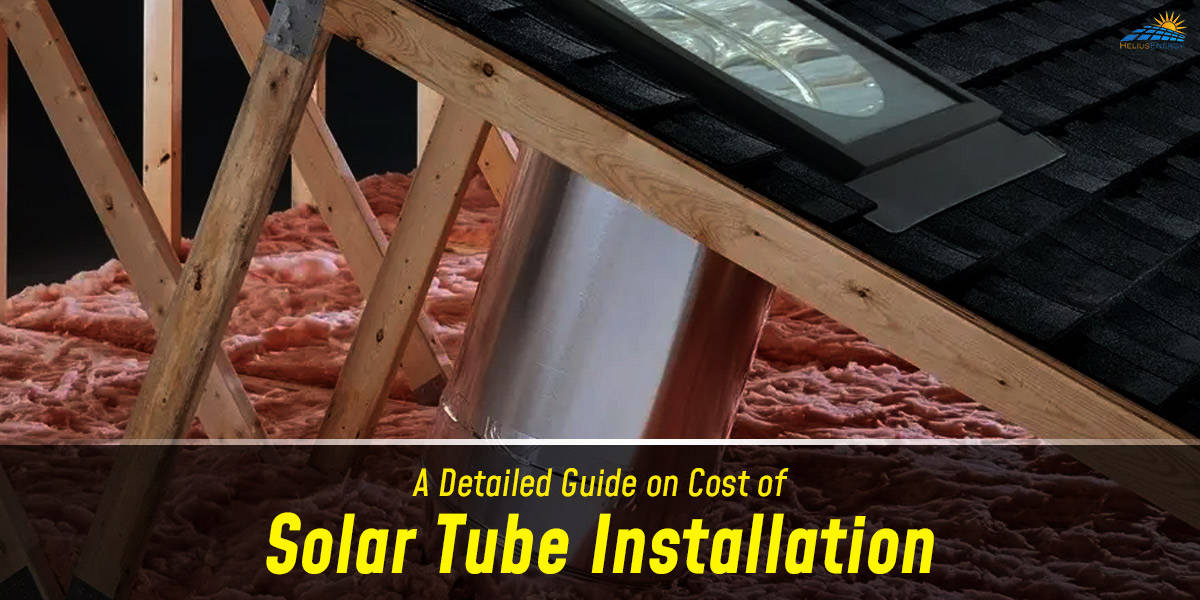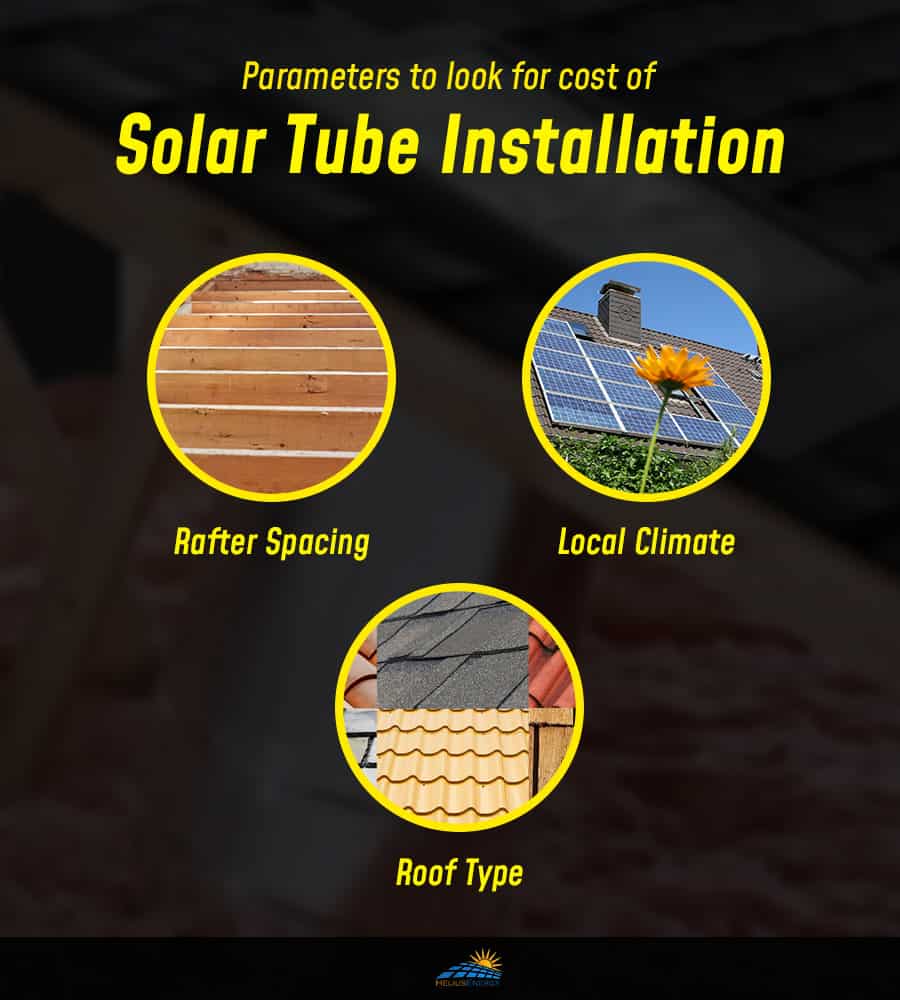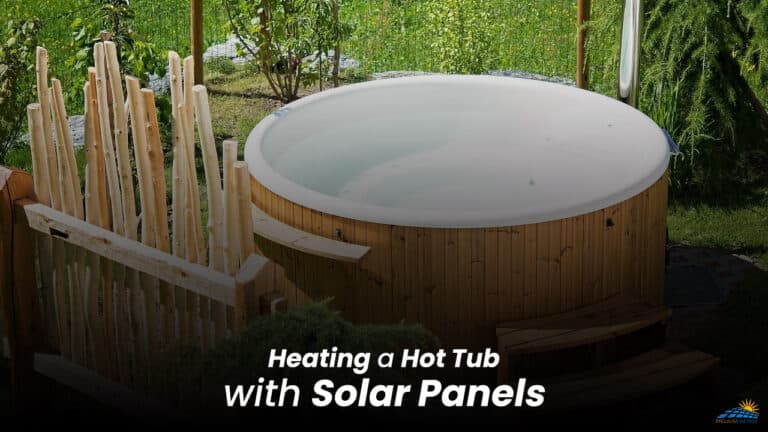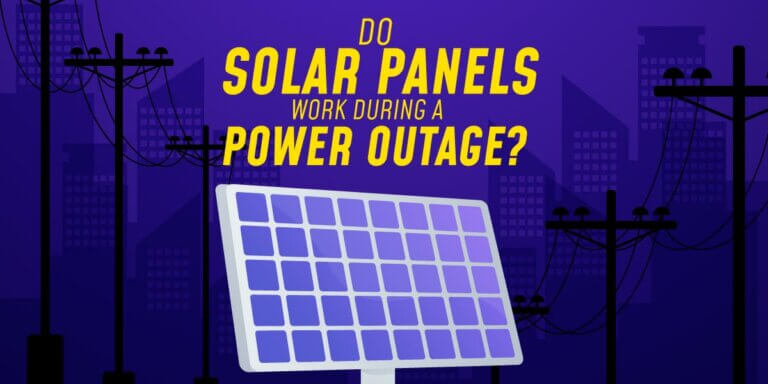A Detailed Guide On Cost Of Solar Tube Installation

Solar tubes are great for illuminating the indoors. They aren’t widely known or used but do brighten up the look of your house. They are made up of a reflecting pipe that carries sunlight to its destination inside your home and a translucent waterproof head that is put into your roof membrane.
When compared to skylights, solar tubes have a few disadvantages, such as a limited exterior view and a poor ability to gather heat from the sun during the winter. Solar tubes do have some important benefits, like their cheaper installation costs, higher energy efficiency, and relatively easy installation.
In this article, we’ll describe how solar tubes work, compare them with skylights and try to give you an estimate of how much solar tube would cost you.
- 1. What Are Solar Tubes?
- 2. How Do Solar Tubes Work?
- 3. Where Can You Install Solar Tubes At Home?
- 4. Should You Get Solar Tubes?
- 5. Parameters To Look For Cost Of Solar Tube Installation
- 6. How Much Is The Cost Of Solar Tubes?
- 7. Cost Of Solar Tube Installation By Yourself
- 8. How Much Do Solar Tubes Cost Compared To Traditional Skylights?
- 9. Final Thoughts
What Are Solar Tubes?
Sun tunnels, light tubes, and daylight pipes are other names for solar tubes, which bring natural light into your house. Even though they block out the view of the external world, they offer a cheap and eco-friendly solution to light up dark indoor spaces naturally.
Solar tubes can be conveniently positioned between roof rafters because of their modest size. This relieves you as a homeowner of concern regarding the stability of your roof. Solar tubes limit heat gains and losses when compared to skylights.
They are a wonderful option for adding daylight to dim, compact rooms in your house, including closets, bathrooms, laundry rooms, and corridors.
How Do Solar Tubes Work?
Optical engineering is used to design solar tube heads, which range in size from about 1 to 2 feet in diameter and are optically constructed to direct as much light as possible into the tunnel below. A transparent, weatherproof acrylic dome is typically used to protect them.
A super-reflective “continuous mirror” coating is applied to the tube skylight’s piping, which allows it to be extended indefinitely and amplifies the direct sunlight as it enters the intended area.
In contrast to rigid solar tube models, the majority of models provide low-profile, flexible tubing, which eliminates the headache of cutting and fitting sheet metal.
Instead of being obtrusive domes, their solar tube variants resemble tiny skylights integrated into the face of your roof. You should give them great attention if you value sleeker aesthetics.
Most solar tubes include a UV ray protection device in the light diffuser at the tube’s end or at the roof’s source of sunshine. This guarantees that the sunshine entering your home won’t harm surfaces or artwork or have a negative impact on your health.
Where Can You Install Solar Tubes At Home?
Many places are seeing a rise in the use of solar tubes, yet people frequently prefer continual indirect light in the following places:
Hallways, Stairs, Kitchens, and Walk-in Closets. You can also install solar tubes in bathrooms and laundry rooms. The one spot where a light tube would be a bad idea is right above a screen, like a computer or TV, as this can cause glare that can be a pain.
Should You Get Solar Tubes?
Solar tubes are an investment that many homeowners make since they quickly reduce electric costs. There don’t seem to be any restrictions on where these tubes can be placed inside a house because installation doesn’t need to include any changes to the building.
Make sure there is adequate space to run a light tube by first taking a look around your attic. Any obstacles must be removed before installation.
Parameters To Look For Cost Of Solar Tube Installation

1. Rafter Spacing
There is plenty of room for either a 10-inch or a 14-inch light tube due to the conventional rafters’ 16-inch center spacing. However, if you discover that the rafters are spaced 24 inches apart, you have the option of obtaining a 21-inch light tube that can illuminate 600 square feet on demand.
2. Local Climate
If you live in a humid environment, condensation may form inside the tube, which could be problematic. Condensation can be significantly decreased by covering the light tube with R-19 or R-15 insulation.
To evacuate the moist air and decrease or eliminate condensation, some solar tube manufacturers offer tubing portions with small fans integrated into them. Consider using extra-durable polycarbonate domes if you reside in a hurricane-prone area.
3. Roof Type
Although light tube kits were made with asphalt shingles in mind, they also perform admirably with shake or wood shingles, both of these materials are considered best roofing materials for solar panels installation as well. For roofs made of metal or tile, flashing adapters are available.
How Much Is The Cost Of Solar Tubes?

Prices for solar tubing depend on diameter size. Homeowners may often anticipate expenditures for tube materials alone to look like this. However, pricing can vary depending on the manufacturer they choose:
- $10-$350 for a 10-inch solar tube
- 14-inch solar tube $400–$550
- Solar tube 18 inches: $600-$750
- $800 and above for solar tubes larger than 19 inches.
You’ll need to acquire a 21-inch tube, especially for your job, if your home’s rafters are spaced 24 inches in the center rather than the more common 16 inches in the center. These may run up to $1,000 each.
Installing solar tubing requires labor between $150 and $250 for each tube. You might delegate the task to a local expert in skylight installation. If your roof needs an adaptor, you may expect to pay more for installation. If your roof is made of something other than asphalt, the installation of the adaptor will cost you an additional $50 to $100.
The costs associated with installation include tracing the tube, drilling holes in the roof and ceiling, installing roof flashing, installing the tube, adding tube extensions, and attaching the light diffuser.
Cost Of Solar Tube Installation By Yourself
If you choose to acquire a kit that ranges in price from $200 to $400, you might be able to manage installation yourself. Solar skylights don’t require any additional drywall, in contrast to conventional skylights.
A somewhat manageable job for a competent homeowner, solar tube kits cost between $200 and $700. If you want to do it yourself and are debating between solar tubes and skylights, keep in mind that solar tubes are less difficult to install than skylights since they are lighter.
How Much Do Solar Tubes Cost Compared To Traditional Skylights?
Installation of a solar tube is less complicated than a skylight. A solar tube may often be erected in two hours or less. Solar tubes are less expensive than skylights because they are simple to install.
In comparison to a skylight, which may cost more than $2,000 to install, a light tube costs between $600 and $1,000. If you’re adept and comfortable working on a roof, you can install a light tube yourself using a kit that costs between $200 and $700. A light tube doesn’t need new drywall, paint, or modifications to the frame members as a skylight requires.
Most light is produced by solar tubes. You will receive 99% of the light entering the tube as opposed to only 36% with a Skylight. This is a result of your home’s exterior having a dome shape, which more effectively collects light. Not to mention, you will also save costs in the long term by cutting down on electricity costs from skylights.
Final Thoughts
Solar tubes are a practical and inexpensive solution to light up your home’s modest, gloomy interior regions. Installing solar tubes costs, on average, $750, which is far cheaper than installing skylights ($1500-$2500).
The cost of DIY kits is around $300. When compared to other types of lighting, solar tubes are very energy-efficient, need little maintenance, and are very simple to install. I hope this article has addressed all your cost issues regarding the installation of solar tubes.






